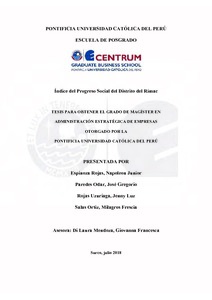| dc.contributor.advisor | Di Laura Mendoza, Giovanna Francesca | |
| dc.contributor.author | Espinoza Rojas, Napoleon Junior | es_ES |
| dc.contributor.author | Paredes Odar, José Gregorio | es_ES |
| dc.contributor.author | Rojas Uzuriaga, Jenny Luz | es_ES |
| dc.contributor.author | Salas Ortiz, Milagros Frescia | es_ES |
| dc.date.accessioned | 2018-09-04T23:44:48Z | |
| dc.date.available | 2018-09-04T23:44:48Z | |
| dc.date.created | 2018 | |
| dc.date.issued | 2018-09-04 | |
| dc.identifier.uri | http://hdl.handle.net/20.500.12404/12579 | |
| dc.description.abstract | El Índice de Progreso Social mide el progreso social en una forma integral e inclusiva,
mostrando la capacidad de una sociedad para satisfacer las necesidades humanas
fundamentales de sus ciudadanos, de establecer cimientos que permitan mejorar y mantener
la calidad de vida de sus ciudadanos y comunidades y de crear las condiciones adecuadas
para que todos los habitantes alcancen su pleno potencial (Social Progress Imperative, s.f.).
El presente trabajo tiene como objetivo principal mostrar el Índice de Progreso Social
del distrito del Rímac así como el nivel de desarrollo de sus tres pilares básicos: (a)
Necesidades Humanas Básicas, (b) Fundamentos del Bienestar, (c) Oportunidades.
El Distrito del Rímac alcanzó a finales del 2017 un puntaje de 39 en el IPS que se
clasifica como un indicador Muy Bajo. Para poder realizar este cálculo se realizó una
zonificación dividiendo el distrito en tres zonas, considerando lo siguiente: la zona 1 tiene un
IPS de 36.80 clasificado con un nivel de IPS Muy Bajo, la zona 2 presenta los mejores
resultados con un IPS de 48.17 clasificado con nivel Medio Bajo y por último la zona 3 con
un IPS de 30.31 con un resultado más bajo clasificado como Extremadamente Bajo.
Asimismo los resultados por dimensiones del distrito del Rímac son como siguen: en
cuanto a las Necesidades Humanas Básicas arrojan un IPS de 60.1 clasificado con un nivel
de Progreso Medio Bajo, en el componente de los Fundamentos de Bienestar arroja un
resultado de 23.4 clasificado como Extremadamente Bajo y el de Oportunidades con un IPS
de 33.2 situándose en el mismo nivel.
Estos resultados del Índice de Progreso Social son un input potencial para que la
Municipalidad Distrital del Rímac direccione sus políticas y recursos focalizándose de
acuerdo a las zonas que necesitan más apoyo así como en las dimensiones del progreso social
que salen con mayor oportunidad de mejora, de esta manera poder mejorar las condiciones de
vida de sus pobladores de una forma más estructurada | es_ES |
| dc.description.abstract | The Social Progress Index measures social progress in a comprehensive and inclusive
way, showing the capacity of a society to satisfy the fundamental human needs of its citizens,
to establish foundations that allow improving and maintaining the quality of life of its citizens
and communities and to create the right conditions for all inhabitants to reach their full
potential (Social Progress Imperative, nd).
The main objective of this work is to show the Rímac district's Social Progress Index
as well as the level of development of its three basic pillars: (a) Basic Human Needs, (b)
Welfare Foundations, (c) Opportunities.
The Rímac District reached at the end of 2017 a score of 39 in the IPS that is
classified as a Very Low indicator. In order to perform this measurement, zoning was done
dividing the district into three zones, considering the following: zone 1 has a IPS of 36.80
classified with a very low IPS level, zone 2 presents the best results with an IPS of 48.17
classified with Low Medium level and finally with Zone 3 with an IPS of 30.31 with a lower
result classified as Extremely Low.
Likewise, the results by dimensions of the district of Rímac are as follows: in terms of
the Basic Human Needs, they give a PSI of 60.1 classified with a level of Low Average
Progress, in the component of the Fundamentals of Wellbeing it gives a result of 23.4
classified as Extremely Low and Opportunity’s with an IPS of 33.2 standing at the same
level.
These results of the Social Progress Index are a potential input for the District
Municipality of Rímac to direct its policies and resources focusing on areas that need more
support as well as on the dimensions of social progress that come out with greater
opportunities for improvement, this way to improve the living conditions of its inhabitants in
a more structured way | es_ES |
| dc.language.iso | spa | es_ES |
| dc.publisher | Pontificia Universidad Católica del Perú | es_ES |
| dc.rights | info:eu-repo/semantics/openAccess | es_ES |
| dc.rights.uri | http://creativecommons.org/licenses/by-nc-nd/2.5/pe/ | * |
| dc.subject | Investigación cuantitativa | es_ES |
| dc.title | Índice del progreso social del distrito del Rímac | es_ES |
| dc.type | info:eu-repo/semantics/masterThesis | es_ES |
| thesis.degree.name | Maestro en Administración Estratégica de Empresas | es_ES |
| thesis.degree.level | Maestría | es_ES |
| thesis.degree.grantor | Pontificia Universidad Católica del Perú. CENTRUM | es_ES |
| thesis.degree.discipline | Administración Estratégica de Empresas | es_ES |
| renati.discipline | 413307 | es_ES |
| renati.level | https://purl.org/pe-repo/renati/level#maestro | es_ES |
| renati.type | https://purl.org/pe-repo/renati/type#tesis | es_ES |
| dc.publisher.country | PE | es_ES |
| dc.subject.ocde | https://purl.org/pe-repo/ocde/ford#5.02.04 | es_ES |






